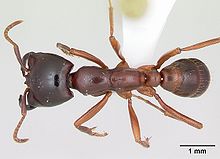Dorylinae: Difference between revisions
Content deleted Content added
Citation bot (talk | contribs) Add: doi-access. | Use this bot. Report bugs. | Suggested by Headbomb | Linked from Wikipedia:WikiProject_Academic_Journals/Journals_cited_by_Wikipedia/Sandbox | #UCB_webform_linked 239/797 |
No edit summary |
||
| Line 13: | Line 13: | ||
}} |
}} |
||
'''Dorylinae''' is an [[ant]] [[subfamily]], with distributions in both the [[Old World]] and [[New World]]. Brady ''et al.'' (2014) [[Synonym (taxonomy)|synonymized]] the previous dorylomorph subfamilies (Aenictinae, Aenictogitoninae, Cerapachyinae, Ecitoninae, and Leptanilloidinae) under Dorylinae.,<ref name="Brady_et_al_2014"/> while Borowiec (2016) reviewed and revised the genera, resurrecting many genera which had previously been merged.<ref name="Borowiec_2016">{{cite journal|last1=Borowiec|first1=M.|title=Generic revision of the ant subfamily Dorylinae (Hymenoptera, Formicidae)|journal=ZooKeys|date=2016|issue=608|pages=1–280|doi=10.3897/zookeys.608.9427|pmid=27559303|pmc=4982377|doi-access=free}}</ref> Dorylinae genera are suggested to have evolved sometime between {{ma|102|74}}, subsequently undergoing rapid adaptive radiation events during their early history.<ref name="Brady_et_al_2014">{{Cite journal | last1 = Brady | first1 = Seán G | last2 =Fisher | first2 = Brian L | last3 =Schultz | first3 = Ted R | last4 =Ward | first4 = Philip S | year = 2014 | title = The rise of army ants and their relatives: diversification of specialized predatory doryline ants | journal = BMC Evolutionary Biology | volume = 14 | pages = 2–14 | doi = 10.1186/1471-2148-14-93 | pmid = 24886136 | pmc = 4021219 }}</ref> |
'''Dorylinae''' is an [[ant]] [[subfamily]], with distributions in both the [[Old World]] and [[New World]]. Brady ''et al.'' (2014) [[Synonym (taxonomy)|synonymized]] the previous dorylomorph subfamilies (Aenictinae, Aenictogitoninae, Cerapachyinae, Ecitoninae, and Leptanilloidinae) under Dorylinae.,<ref name="Brady_et_al_2014"/> while Borowiec (2016) reviewed and revised the genera, resurrecting many genera which had previously been merged.<ref name="Borowiec_2016">{{cite journal|last1=Borowiec|first1=M.|title=Generic revision of the ant subfamily Dorylinae (Hymenoptera, Formicidae)|journal=ZooKeys|date=2016|issue=608|pages=1–280|doi=10.3897/zookeys.608.9427|pmid=27559303|pmc=4982377|doi-access=free}}</ref> Dorylinae genera are suggested to have evolved sometime between {{ma|102|74}}, subsequently undergoing rapid [[adaptive radiation]] events during their early history.<ref name="Brady_et_al_2014">{{Cite journal | last1 = Brady | first1 = Seán G | last2 =Fisher | first2 = Brian L | last3 =Schultz | first3 = Ted R | last4 =Ward | first4 = Philip S | year = 2014 | title = The rise of army ants and their relatives: diversification of specialized predatory doryline ants | journal = BMC Evolutionary Biology | volume = 14 | pages = 2–14 | doi = 10.1186/1471-2148-14-93 | pmid = 24886136 | pmc = 4021219 }}</ref> |
||
==Genera== |
==Genera== |
||
Revision as of 13:55, 1 October 2022
| Dorylinae | |
|---|---|

| |
| D. gribodoi | |
| Scientific classification | |
| Domain: | Eukaryota |
| Kingdom: | Animalia |
| Phylum: | Arthropoda |
| Class: | Insecta |
| Order: | Hymenoptera |
| Family: | Formicidae |
| Subfamily: | Dorylinae Leach, 1815 |
| Type genus | |
| Dorylus Fabricius, 1793
| |
| Diversity[1] | |
| 28 genera | |
Dorylinae is an ant subfamily, with distributions in both the Old World and New World. Brady et al. (2014) synonymized the previous dorylomorph subfamilies (Aenictinae, Aenictogitoninae, Cerapachyinae, Ecitoninae, and Leptanilloidinae) under Dorylinae.,[2] while Borowiec (2016) reviewed and revised the genera, resurrecting many genera which had previously been merged.[3] Dorylinae genera are suggested to have evolved sometime between 102 to 74 million years ago, subsequently undergoing rapid adaptive radiation events during their early history.[2]
Genera
- Acanthostichus Mayr, 1887
- Aenictogiton Emery, 1901
- Aenictus Shuckard, 1840
- Cerapachys Smith, 1857
- Cheliomyrmex Mayr, 1870
- Chrysapace Crawley, 1924
- Cylindromyrmex Mayr, 1870
- Dorylus Fabricius, 1793
- Eburopone Borowiec, 2016
- Eciton Latreille, 1804
- Eusphinctus Emery, 1893
- Labidus Jurine, 1807
- Leptanilloides Mann, 1923
- Lioponera Mayr, 1879
- Lividopone Bolton & Fisher, 2016
- Neivamyrmex Borgmeier, 1940
- Neocerapachys Borowiec, 2016
- Nomamyrmex Borgmeier, 1936
- Ooceraea Roger, 1862
- Parasyscia Emery, 1882
- †Procerapachys Wheeler, 1915
- Simopone Forel, 1891
- Sphinctomyrmex Mayr, 1866
- Syscia Roger, 1861
- Tanipone Bolton & Fisher, 2012
- Vicinopone Bolton & Fisher, 2012
- Yunodorylus Xu, 2000
- Zasphinctus Wheeler, 1918
References
- ^ Bolton, B. (2016). "Dorylinae". AntCat. Retrieved 19 October 2016.
- ^ a b Brady, Seán G; Fisher, Brian L; Schultz, Ted R; Ward, Philip S (2014). "The rise of army ants and their relatives: diversification of specialized predatory doryline ants". BMC Evolutionary Biology. 14: 2–14. doi:10.1186/1471-2148-14-93. PMC 4021219. PMID 24886136.
{{cite journal}}: CS1 maint: unflagged free DOI (link) - ^ Borowiec, M. (2016). "Generic revision of the ant subfamily Dorylinae (Hymenoptera, Formicidae)". ZooKeys (608): 1–280. doi:10.3897/zookeys.608.9427. PMC 4982377. PMID 27559303.
External links
 Media related to Dorylinae at Wikimedia Commons
Media related to Dorylinae at Wikimedia Commons
